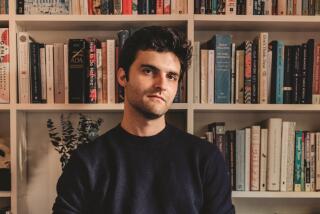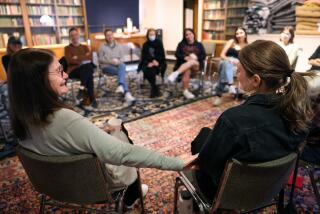Facebook group helped with cancer support, mourning
- Share via
Apryl Lundsten was, in her own words, “not a good Facebook user.”
“Facebook made me uncomfortable. I’d post something, and somebody would answer, and I’d be like, ‘Oh, my God, do I have to answer them?’ I just had performance anxiety. I didn’t see the benefit.”
Then, in February 2011, her husband, David Spancer, a Web producer, was diagnosed with a serious illness. A friend created a Facebook group for Apryl to use to keep family and friends informed. The group’s name: David Spancer’s Got Cancer.
The group became a lifeline for Apryl and David, who lived in Eagle Rock — a source of comfort and connection during a painful and frightening time. As David’s condition became all-consuming, with days upon days given over to doctors’ appointments, chemotherapy, fatigue and sickness, Apryl and David had little time to benefit from the companionship of friends when they needed it most. That’s where social media came in.
Initially, Apryl saw the group simply as a timesaver. In the first days of David’s diagnosis of colon cancer, she’d been overwhelmed by the number of concerned emails and text messages that poured in from friends and family. Responding to everyone would have been a full-time job, so Apryl began using the group to send updates on David’s condition — as did David, when he was feeling well. But over time, the group became something far greater than a series of progress reports — it became critical to Apryl and David’s emotional well being as well as that of their social network — even though there were a few unforeseen complexities.
Karen North, director of USC’s Annenberg Program on Online Communities, says that the practice of using online community tools to connect deeply with friends and family is on the rise. “People are engaging their loved ones for important life events including struggling with the challenges of an illness, sharing relationships and weddings, engaging others in the upbringing of their children — showing pictures, telling stories, asking for advice or support, and more.” Though Facebook has been criticized as a font of useless narcissism, this type of helpful sharing often feels very personal, especially if the creator includes pictures, videos and audio as well as text, North says.
Apryl says of her early efforts to document David’s daily experience: “I thought, ‘Nobody’s going to find this interesting, but I’m going to do this because I know at least two people are interested.” But Apryl began hearing from people who went to Facebook every day, sometimes several times, just to check David’s page.
David’s mother was one of these, and she went from an infrequent social media user to a devotee. “I ended up seeing how absolutely fantastic it could be,” said Cookie Spancer. “To watch people who didn’t know each other from different generations and different parts of the country find that they had things in common was fascinating.”
Apryl, who has worked as a journalist, began to feel a duty to report on David’s cancer in the way a journalist would — and that duty became a source of solace. Often, she would post before bed each night, which became a comfortable routine during a time with few comforts or routines. The feedback was immediate, with replies often coming in seconds. “We weren’t seeing people in person, but we were constantly able to go to the site and have supportive words, or stories, or things people thought we would be interested in.”
Since David had several comedy writer friends, gallows humor and no-holds-barred jokes about the indignities of invasive medical procedures were a staple feature of the group’s content, side by side with descriptions of the hope, anguish and hardship of daily life as a cancer patient.
The group quickly swelled to more than 300 members, with friends, co-workers from David’s job at ABC, family near the couple’s home and in more far-flung locations gathering for daily news of David’s condition. Then more were invited to join the group — people who had relatives or friends of friends with cancer. “They thought that these people would find some comfort out of it,” Apryl says.
That was one point at which things grew briefly uncomfortable — having the details of his illness aired on the Internet not only to loved ones but also to strangers. For a time it got to be too much for David, with the tangled Venn diagrams creating circles noGoogle+user would ever think to overlap. At one point, David culled everyone with whom he wasn’t personally acquainted and changed the membership to invitation only.
The group’s magnetism was as much because of Apryl’s skills as a writer as to David’s particular hunger for seizing every possible opportunity to laugh at his situation. After David learned that his cancer was terminal, he wrote a David Letterman-style list of “Things I’m Not Going To Miss When I’m Dead.” Included: “94.7 The Wave. Cheese Nips. Liverwurst. Ziggy. Florida. The Metric System.”
As his situation became more serious, David’s group also became a way to keep friends at a distance, giving the family much-needed privacy when David wasn’t up for visitors. “Because he was dying, he didn’t have the energy or the stamina to see anyone in person anymore,” Apryl says. “He didn’t have the ability to call people anymore and have long conversations or even send personal emails. So it really was a way for him to maintain his connections with all of his friends. And he really felt connected at the end.”
As David’s condition worsened, the number of posts to the group swelled. This meant that David was able to experience something akin to a common fantasy: attending your own funeral. Often, he was awe struck by the emotional testimonies posted to the group. “People really put themselves out there,” Apryl says. “People felt safe enough to say things, to say how they really felt, and sound vulnerable, and David was OK to be vulnerable too.”
Yet this outpouring led to another uncomfortable moment for Apryl. As it became known that David had only days to live, a few posters began to write of him in the past tense, posting comments that read more like eulogies. His eyesight failing, Apryl had been reading every one of the group’s posts to David aloud, but she had to carefully reword the past tense to present as she read. “Like if someone wrote ‘David Spancer was this,’ I would read it as ‘David Spancer is this’ instead.”
Two vigils were kept as David was dying — one by his bedside, kept by his closest family, and one kept in front of computer screens as others waited at his page for word of his passing, posting messages of comfort and sorrow to one another. When David finally did pass on, a few months shy of his 44th birthday, word went out by telephone. Then it gradually trickled its way back onto his page.
Five months after David’s death, the page still gets regular posts, mostly from friends sharing humorous observations in a “David would have loved this” vein. One small group of friends went to the desert to shoot a mortar filled with fireworks and some of David’s ashes into the sky, and they posted video of the sparkling blast to the page.
Apryl views social media’s role in David’s last months with gratitude. “The last two weeks of his life were totally surreal. I felt like I was in a bubble, because I had to be there while he was dying, and so Facebook provided a way to reach out to the world outside. And everything was focused on him, and making sure that he was out of pain, so it was my connection to the outside world.”
The experience ultimately changed Apryl’s view of social media. She felt that it was being used to its highest potential. “It wasn’t superficial. It was a very real thing. Especially in those last days, in all the memories, and all the pictures, and all the things that people were posting. We went through it together on Facebook, from the beginning of his diagnosis to his last breath. I felt like everyone was there with me as all of these things happened.”
More to Read
The biggest entertainment stories
Get our big stories about Hollywood, film, television, music, arts, culture and more right in your inbox as soon as they publish.
You may occasionally receive promotional content from the Los Angeles Times.










